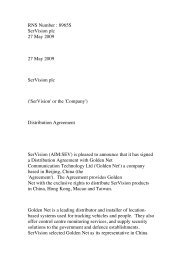TVG-Series System Guide v1-4 - SerVision
TVG-Series System Guide v1-4 - SerVision
TVG-Series System Guide v1-4 - SerVision
Create successful ePaper yourself
Turn your PDF publications into a flip-book with our unique Google optimized e-Paper software.
<strong>SerVision</strong><br />
<strong>TVG</strong> <strong>System</strong> <strong>Guide</strong><br />
• Field<br />
Baud Rate<br />
Connection<br />
Type<br />
Camera ID<br />
• Description<br />
Select the baud rate used by the camera for PTZ control.<br />
Note: Consult the camera documentation or the camera vendor for this information.<br />
Note: The other connection parameters required by the <strong>TVG</strong> are:<br />
one start bit, one stop bit, no parity, and 8-bit. If the camera uses different parameters,<br />
please contact your vendor.<br />
Select the type of connection that is used for the PTZ controls – RS232 or RS-485.<br />
Note: Consult the camera documentation or the camera vendor for this information.<br />
Note: If multiple PTZ cameras that use the RS485 connection type are connected to the <strong>TVG</strong><br />
unit, they must all use the same protocol.<br />
If the camera is connected using RS485, specify its ID number.<br />
Note: This number must correspond to the camera ID that is set on the camera. Consult the<br />
camera documentation for information about setting the camera ID. If multiple PTZ cameras<br />
using the RS485 connection are connected to the <strong>TVG</strong> unit, they must have distinct camera<br />
IDs.<br />
Video Motion Detection (VMD)<br />
When Video Motion Detection (VMD) is enabled, the <strong>TVG</strong> automatically checks the field of view (FOV) of the<br />
camera for changes. When changes are detected, the <strong>TVG</strong> triggers a VMD event. You can configure the VMD<br />
itself, and the event notifications that are generated when VMD events are triggered.<br />
About VMD Regions<br />
The FOV is divided into regions, and the relative sensitivity of the motion detection can vary from region to region.<br />
For example, if a computer monitor in the FOV of the camera causes motion detection events to be triggered<br />
unnecessarily, you can choose to mark the region of the monitor for low sensitivity, or even no motion detection,<br />
while the rest of the FOV would have high sensitivity. In addition, you can completely black out regions from the<br />
FOV if you do not want them included in the video images at all.<br />
If the camera is connected to the <strong>TVG</strong>, and regions are enabled, the Camera configuration screen shows the current<br />
FOV of the camera. Regions that are included in motion detection are marked with a colored x: blue for low<br />
sensitivity, green for medium sensitivity, and red for high sensitivity. Regions that are not included in motion<br />
detection are not marked, and regions that are not included in the video images at all are marked with a black x on a<br />
white background.<br />
NOTE:<br />
If VMD is enabled, but regions are not, middle sensitivity is applied to the entire FOV.<br />
NOTE:<br />
If the camera is not connected to the <strong>TVG</strong>, a blank tan image is displayed. It is recommended that you<br />
select the regions for inclusion in VMD when you can see an actual image.<br />
About VMD Event Settings<br />
A VMD event starts when motion is first detected and ends when there is no motion. However, in many cases what<br />
is seen by the human eye as one event can be interpreted by the VMD system as a series of motions with idle<br />
periods. When this occurs, a single motion event is broken into a series of short events. On the other hand, a motion<br />
event as detected by the VMD system can be exhaustingly long, such as a full day in a busy shop. In this case, we<br />
would prefer to break it down into a number of shorter events.<br />
Configuring Camera Settings 88





